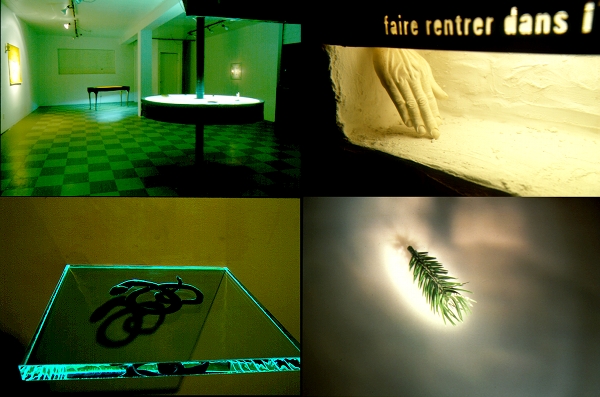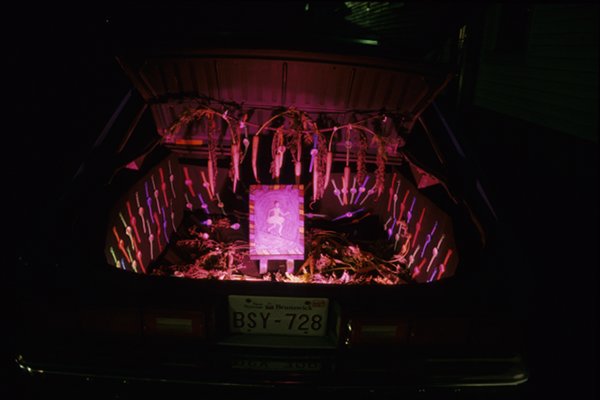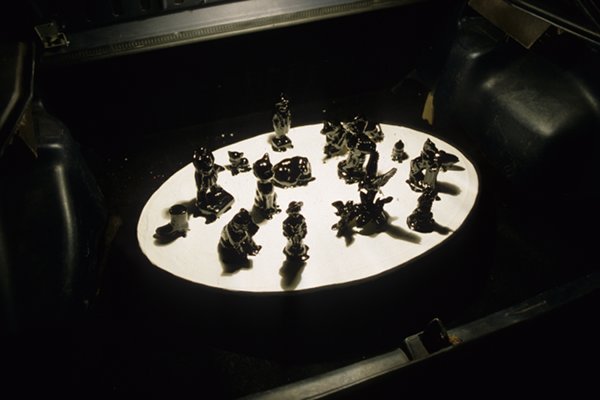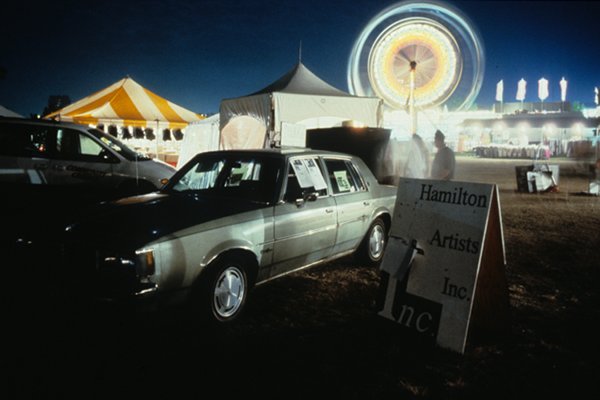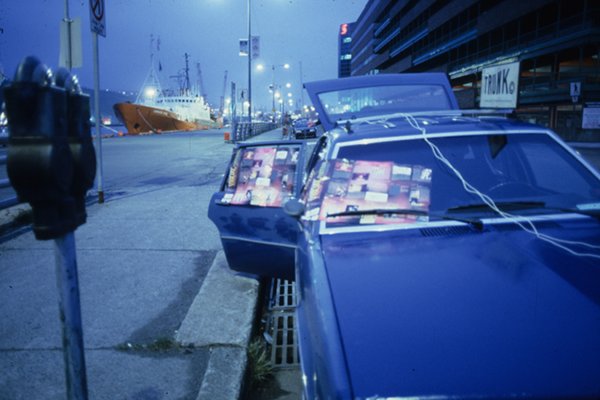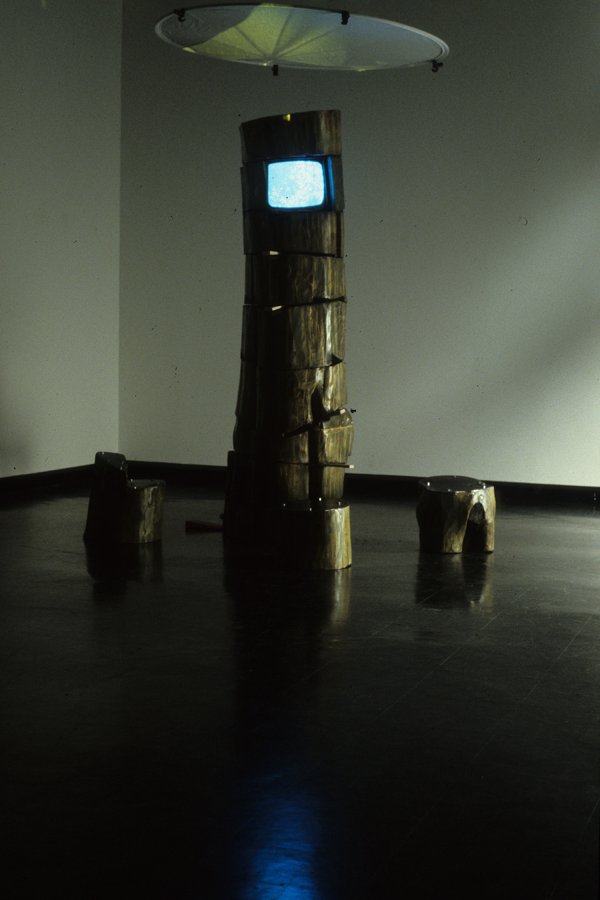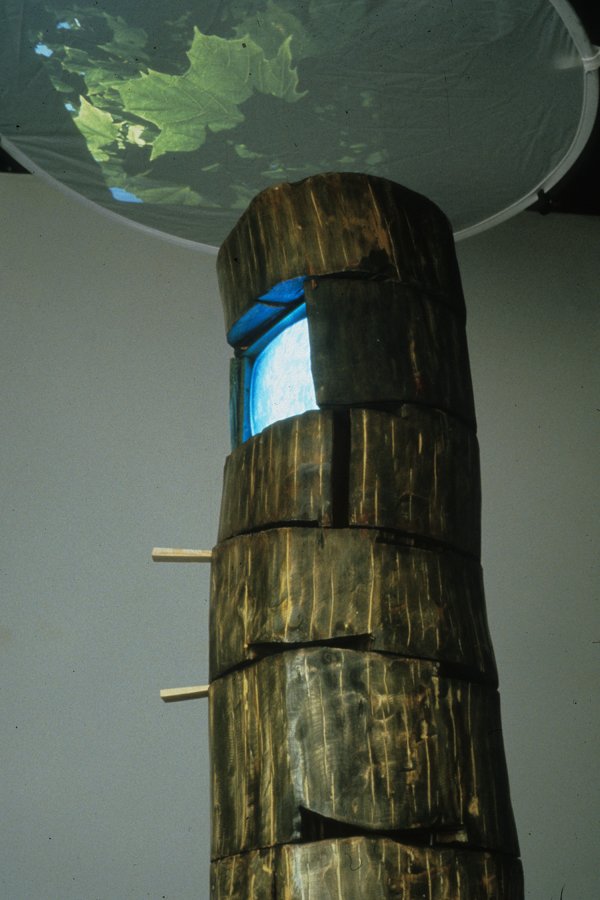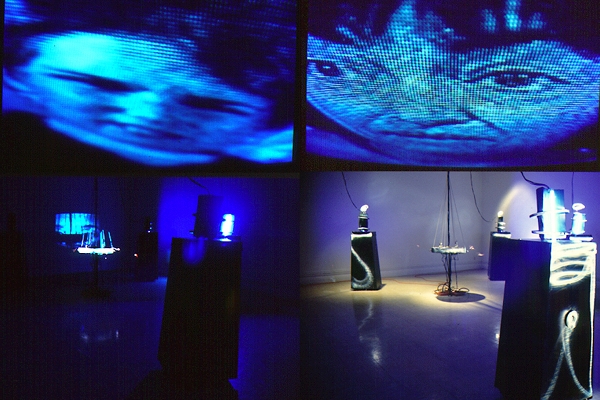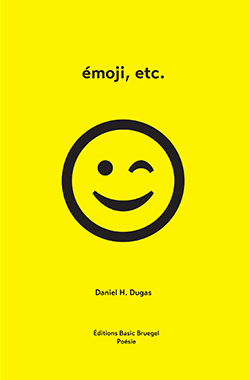Foundwealth (1999)
Struts Gallery, Sackville, NB March 12 – April 3, 1999
Artcite, Windsor, ON May 18 – June 16 2001
FOUNDWEALTH is about seeing the light. To see it indicates both, the end of a journey, and the beginning of a certain level of hope. The moment where the light is seen is a moment where space and time are crunched together into a new thing. It is the split second where choices are made. I want the installation to be about that moment, where everything could happen. This moment of decision or indecision looks a lot like our point in time; the crossing of the two millenniums. It seems as if we are moving into a corridor of weightlessness. It seems that the EXIT and the ENTRY, the GOOD BYE and WELCOME signs do not have any particular places. Like astronauts in a tube, we have to look, while lost in the dark, at the light that may come through the cracks, to guide and to inspire us to continue forward, to believe that there is some worth in everything and maybe wealth is not what we thought at first.
Is wealth something that one can find, like a fat wallet on the sidewalk? How can wealth be lost? How can it be found and how can it be maintained? Maybe it happens simply, by fortune, while strolling down by the lake, by the river, or going home late at night. Maybe it happens by ingenuity. Perhaps it is a bit of both, luck and skills, patience and audacity.
FOUNDWEALTH is constructed around a few historical moments. In 1776, the Scottish economist, Adam Smith wrote in his book An inquiry into the Nature and Causes of the Wealth of Nations about the invisible hand that comes and regulates the economy. In 1848, John August Sutter, the man who was in the process, through his sawmills, of becoming one of the wealthiest man on the Pacific coast, was ruin by the discovery of gold on his own property. In 1891, the Pope Leo the 13th wrote an encyclical letter on the condition of the working classes. References to the work of Alchemists; the all-purpose curative liquid A.K.A. – Snake Oil; and the Greased Pole where goods where hung during village fairs inform this installation.
FOUNDWEALTH is a poetic reflection and a kind of frontal collision-relationship of the rich and the poor. It is a bridge made of burning rags and thrown over the abyss where the river called Economy runs furiously. I want the carpet-cleaning trainee to talk to the capital risk investor. I want to know if the parents are telling the story of how the good RSSP bear grew so big in their own forest preserve.
FOUNDWEALTH is made up of seven works. Those works bear reference to the number 7, which has always held a powerful and mystical place in History. We only have to think of the Seven Seas; the navigable waters of the world; forming that road to treasure and adventure; the Seven Marvels of the World which included the lighthouse in Alexandria; the Seventh Heaven where God and the most exalted angels dwell; the Seven Deadly Sins (among them, Envy); and the Seven Eleven, a place where you can buy a 6-49 ticket.
Daniel Dugas, Shemogue NB February 1999

Daniel Dugas peers into a glass sculpture that is part of his recent art installation, FOUNDWEALTH
Art by Installation
Daniel Dugas’ last exhibit forced viewers to questions what it means to be wealthy
By Alison Hughes
in Sackville
LUMINOUS lighting emanates from seven surfaces in the dim room. It radiates through yellow plastic beads, shines on carved glass and illuminates messages set into plain white walls.
The exhibit’s overall effect is deceptively simple, but behind the constructions making up Daniel Dugas’ latest art installation is a complex thought process. Drawing on influences from medieval alchemy to modem economics, FOUNDWEALTH uses audiotapes, found art objects and sculpture to examine conflicting ideas about what it means to be wealthy.
A self-described “pluri disciplinary artist,” Dugas has been pushing the artistic envelope since completing a Bachelor of Fine Arts degree at the Université de Moncton, in 1986. His resume includes 12 solo exhibitions, 24 two-person and group shows, as well as dozens of audio, video, radio and performance credits.
Dugas bas received numerous Canada Council and provincial Creation grants for his projects, along with funding from several art institutes. These have led to travel opportunities throughout North America, Europe and Asia, including a role as a Canadian representative at the 1997 Jeux de La Francophonie, in Madagascar.
While working for a year at the Banff Centre for the Arts, Dugas met and began collaborating with his partner Valerie LeBlanc. Together, they headed off to the Art Institute of Chicago.
With LeBlanc originally from Halifax and Dugas raised primarily in Moncton, the two eventually moved to New Brunswick. Here, they gained notoriety in 1996 by travelling to small towns with an exhibit known as the Trunk Gallery. People paid a dollar to look inside the hatchback of a Citation to see the couple’s custom-designed audiovisual installation. After Peter Gzowski interviewed them about this unique way of taking art to the people, they received calls from all across the country.
“A lot of people would go to a Legion, but never to a gallery,” Dugas says. “There’s also a need for more populist art. I think it’s important for an artist to have reactions from many people in order to grow.”
In FOUNDWEALTH, Dugas questions whether wealth is anything more than a marketing illusion in today’s society. The show’s first installation is a wall-mounted piece of beveled glass with the exhibit title etched elegantly into the surface. In front of this hangs a bare bulb with a symbolic and functional string attached.
As a motor on the floor turns noisily around, it moves the string and causes a shadow title on the wall to shrink and grow with rhythmic regularity. This hypnotic motion draws in the viewer, suggesting wealth’s seductive power. Simultaneously, it reveals the crude machinery working behind the scenes to create expensive polished products.
Dugas cleverly combines public perceptions with personal research in offering his insights into the origins of wealth. Central to this installation, both physically and conceptually, is a circular light table. A pole rising from the centre represents the medieval greased pole where foodstuffs used to be hung during celebrations, for those hungry, agile and determined enough to reach them.
On the table itself, seven carefully chosen found objects are displayed like jewels. Each of the items, from a broken doll to a pinecone, has a word written on the surface, forming the sentence “I always thought there were seven seas.”
“The roots of wealth were originally the seven seas,” Dugas explains. “But when I got out a globe, I counted 33 seas. It’s like the growth of wealth parallels the number of seas. That’s the terrible beauty of the free market, that it always finds a way to grow,” he says. “It’s both creativity and cancer, and the role of society is to decide the boundaries.”
A voluminous and eclectic reader, Dugas explored economic limits in the exhibit through three seemingly unrelated men: 18th-century Scottish founder of capitalism Adam Smith, late-19th-century Pope Leo the 13th and mid-19th-century California lumber baron John Sutter.
A white plaster hand mounted in an opening in the gallery wall symbolizes the “invisible hand” Smith described as regulating the free-market economy.
Sutter serves as a warning that even hard work and capability aren’t enough to ensure wealth if the timing is wrong. The millionaire sawmill owner was ruined by the discovery of gold on his property and the subsequent gold rush fever. In the exhibit, a carefully crafted walnut light table holds a pile of yellow plastic beads that look like gold, but have no inherent value.
Having lived the hand-to-mouth existence of an artist for many years, Dugas has given considerable thought to the role of money in society. Like a magpie, he picked up shiny fragments about wealth from novels, financial pages and personal observations during the year it took to assemble the show.
While this installation hasn’t been purchased by a collecting institution, as others have been in the past, Dugas considers it a success. As he begins to dismantle these pieces, though, his mind is on the multitude of other projects awaiting attention. He has just published his fourth poetry chapbook and together with Ms. LeBlanc is preparing more manuscripts for a launch later this spring. Then, there is another word-based project involving parking lots and an audio production already under way. Dugas is also a musician.
“Projects are like kids. The one that squeaks the most gets finished,” he laughs. “Valerie is a very productive artist too. Often we say ‘gee, wouldn’t it be nice to just look out the window and be bored?’ ”
As well as pursuing their own art projects, the couple runs a high-end glass-carving business, producing presentation items and architectural details. Both enjoy the freedom of working together at home in Shemogue, not far from Shediac. Dugas still feels the urgency to communicate ideas through painting, sculpture and other media. Whether the projects are about nature and civilization, media manipulation, or found wealth, he plans to continue making art that stimulates thought about challenging subjects.
“With the crossing of the two millenniums, we’re a bit like in a corridor of weightlessness; the entry and the exit signs, the welcome and the goodbye signs, we don’t seem to have a specific place,” he muses. “I think it’s very important to have a feeling of hope and of the importance of what you’re doing- that it’s of value. ”
Telegraph Journal
April 17, 1999
TRUNK© gallery (1996-1999)
• Eastern Edge, Gold / Rush, (TRUNK©), Contemporary Visual Festival, St-John’s, NF
• Hamilton Artist Inc.,Gold / Rush, (TRUNK©) Hamilton, ON
• Itinérant / Mobile, Moncton, Notre-Dame, Sackville, NB, 1996-1997
Historic:
TRUNK© was created in October of 1996 by Daniel Dugas and Valerie LeBlanc. At that time we were just coming back into the Maritimes from living in the US and in Alberta for 7 years. We found ourselves in a time period where we had no place to show our work and instead of waiting out that long period between the application and the opening night, we made our own art centre. We drove our 1981 RCMP blue Citation around, opening the trunk for the interested and the curious. The TRUNK© contained a new art installation each month. The slogan for TRUNK© was the very apropos exhibitions near you ™. We also wanted to develop a new audience, and the experience was fascinating; many of our viewers never went inside an art gallery, but they enjoyed the space that we had created. The reaction was immediate and overwhelmingly positive. Newpapers and television stations started to talk about the TRUNK© which became a collective with the addition of Luc Charette. In just a few months, we were talking to Peter Gzowski on CBC radio, coast to coast.
Opening the TRUNK© to Release the 9 to 5
by Valerie LeBlanc
MIX magazine 25.3 Winter 1999/2000
At the hinge of the millenium, it is somewhat incredible to observe that the main cogwheels of the working world still turn from 9-5. In all of the planning sessions and working hours that have passed since humans began walking on the planet, the expression ‘flex hours’ still implies being on duty from dawn to dusk. The current status of progress is to work the standard number of required hours, with the option to start anywhere between 7:15 and 8:30, that’s a.m.
In the early decades of the post-World War 2 period, an age-old slogan from previous industrial revolutions was touted: ‘ Machines Will Set You Free.’ The birth of the across-the-board consultant era came in the 1990’s. This time, the promise of freedom to work your own hours was flaunted. Currently, with the polarization of high end and low end employment, the common schedule has blurred into an endless on-call hotline. Yet the buzz of commuter trains, buses, cars and SUV’s is still heard from 9 to 5.
That being stated, it seems that no one gets any real time off these days, unless they are out of work. Add in the stress factor of figuring out ‘what’s up next but the street,’ and that time off comes close to full mental taxation. A quick scan of current mass media advertising and entertainment reveals a neat interweaving of the things which were once discernable: the public and the private; the worktime and the downtime. In essence that old 9 to 5 has moved into the home environment, pushing to make a blur of all downtime. There is no world except the Brave New Working World.
Starting out in life, I saw the warning signs. I saw the cards stacking up and yet I jumped into an artistic career. I chose my path and dug in. For years I thought that it was a choice. Then I came to realize that the trap was set for me before I started. With tongue in cheek I write, I am an artist and there is no escaping from it after a certain point. I long ago coined the phrase ‘Art is Two Full Time Jobs. ‘ So all of that business about observing the structure of the workforce while being submerged in it, is, in essence, a pile of baloney. When I get home from work, I ‘go to work’ on whatever art projects I have on the go at the time. Artists continue to beat the same paths. The rewarding part is that as an individual, you can have control over a few choices.
As an interdisciplinary artist, I have trained, tried and continue to call up many forms of expression in the usual course of creation. Leads come to me as ideas, images or feelings. They trigger interest and stick in my mind, as I start to compile and to formulate scraps of information. Once aroused, artistic interest does not always fit conveniently into the time patterns marked out by the physical world, especially when constrained by the business of bill paying. The seeds of art making arrive during those pragmatic moments when I am locked in the 9 to 5, under stressful circumstances, during pauses, dreams, and when I submerge myself into personal ‘thinktank’ sessions. When the moment is not convenient to pursue the train of thought, I jot down a few key words, or I make some sketches to later remind me of where things were going.
When I get a chance, I pull out these scraps and start to build on them. Usually it is a long and convoluted process. Understandably, it is a solitary path. At best, at the end of a year or two of progress, I can look forward to an exhibition which will last for three weeks. If I am really lucky, I might garner Andy Wharhol’s “ten minutes of fame” during a review. A bit of publicity, and that is the best case scenario. A drop in the bucket, and then its back to the studio drawing board, and the cycle begins again. Yes, the point is that I love my life and that is why I continue to hack through this jungle with such ferocity.
And while hacking, I got on the kick of raising the visibility and honour of the working world. More specifically, I tried to offer some recognition to people ‘in general’ for their efforts to tame the overpowering ‘WORKING MACHINE'; the same beast to which the majority of human beings are enslaved. Well HA! – and good luck! One thing that has changed in the past few years is that I have learned to listen more carefully to the advice of the non-secular faction. I used to ravage through projects like an island. I worked a lot of things out of my system, so to speak. In spite of what family and friends, even professional advisors told me, I continued to believe in the value of raising the concept of the everyday. My work was marinated in the 9 to 5. Then, I came to embrace the concept which was flashing in neon around each corner: NO ONE WANTS TO BE REMINDED OF THE WORKING WORLD. It is exactly the other, the special event, that which stands out from the everyday that people want to experience.
The significance of stating this very basic revelation is that I have started to have fun giving people what they want. It is not the kind of project that I sweat over the most, and it does not take exaggerated amounts of time to produce. What is this snake oil? It is the TRUNK© Gallery. And it is not a lonely venture, it is a community at large. It is a kind of working vacation.
This summer Daniel Dugas and myself took a break from the 9 to 5 when we travelled to exhibit the TRUNK© – GOLD / RUSH project in Hamilton, Ontario and in Saint John’s, Newfoundland. The Hamilton Artists Inc. invited us to present as the sixth element in its year long Perpetual Crisis Series. For GOLD, Daniel Dugas asked the Centre’s members to gather recycled glass before he arrived in town. He broke the glass, piled it up in the trunk of the car, and lit it with amber lights. He then invited people to “handle the gold.” He offered a pair of heavy leather welder’s gloves for protection. Most viewers took advantage of the chance to get closer to ‘his wealth’. My RUSH exhibit involved a circulating champagne fountain filled with water and lit with coloured lights. That was the lure, along with an instrumental version of Three Coins in a Fountain. When I was able to draw people closer, I interviewed them about water memories and vacations. The second stage of the projects was to tour Dugas’ GOLD around the city, parking at randomly chosen, busy corners. Because we were scheduled into the Royal Bank Aquafest of Music, we also set up on the midway of the festival. Amid the carnival rides, gambling wheels, food kiosks and curio boutiques, we parked the borrowed 1986 Cutlass Supreme Oldsmobile and opened the TRUNK©. For this second stage of the project, Dugas’ shared his wealth and I played back a sound bites of story samples mixed with the song track. The reaction was very positive. The ‘normally curious’ warmed up right away to the TRUNK©, and the ‘normally sceptic’ dug in to ask all of the questions you can imagine. As artists we had a lot of fun talking to people and embracing their curiosity. We shared laughter and tears with people drawn to this ‘in your face’ encounter.
In St. John’s, Newfoundland, we were part Eastern Edge Gallery’s first Contemporary Visual Festival. By inviting a variety of ‘out of the gallery’ artistic ventures, Eastern Edge was specifically challenging the artist and viewer to re-contextualize the parameters of what is included in the dialogue of ‘ART.’ Daniel Dugas repeated the GOLD show, RUSH was changed to suit the new location. Because Newfoundland was celebrating fifty years in the Canadian Confederation, I placed a few time pieces in the TRUNK© as visuals. The questions I asked were related to the concept of whether time equals money, and if people got enough time off, enough time for themselves. I played the mix back from a loud speaker unit on top of the car while driving around the city.
The TRUNK© GOLD / RUSH was similar for each of these summer venues but the locations of Hamilton and St. John’s provided completely different experiences. Again, in St. John’s there were the instantly curious, and the initially sceptic, and we always found people to be surprised at the public encounter. From the artists’ perspective, it was a chance to see and to talk to dozens of people that would normally avoid art exhibits. It tested our reactions to the sometimes astonished passerbys. It also offered the chance for two short working vacations this summer. We managed to escape the 9 to 5 grind of trying to make ends meet during those two TRUNK© excursions. It was inspiring and refreshing enough to carry us through until ‘so-far’, the late fall.
Now that I have finally been able to embrace the concept of the ‘other’, which people want, need, and will appreciate, I am truly able to create from real life. This fast paced form of artmaking which touches on installation and performance demands that the artist work ‘on the fly’ with the reactions of the chance audience. The artist must catch the interest of the passerby and reach into that person’s take on being stopped in the street. The artist has to be offering something better than a confrontation sales pitch to successfully draw someone from their pursuit of happiness. One man in St. John’s broke into my ‘speel’ to ask what the TRUNK© was about. Initially, his tone was confrontational. After explaining it to him in detail he began to get interested, finally he he added the comment, “So it is a sort of ‘think-trunk’.” I took it as a big compliment and felt that he offered me the gift of ‘interpreting what I was doing there and throwing it back to me’.
As an interdisciplinary artist, I use my skills to explore the limits of artistic creation. I create to clarify my take on the world, and to communicate my findings. Consequently, my body of work passes through a series of recurring cycles in both intent and physical appearance. The whole of it makes up who I am and what I do. The TRUNK© Gallery enables me to work as ‘animator’, presenting an installation scenario for contemplation. The passerby becomes the audience and I ‘work the crowd’ in the fashion of the food demonstrator in a grocery store. I give people something to think about, and I work to exchange a few laughs. A good time is passed on without obligation. The TRUNK© Gallery requires and enables me to synthesize a full gamut of skills and techniques to realize my aim to communicate.
When artists step out of the Gallery, art transforms itself to fit into the skin of the contemporary commedia dell’arte. The Canada Council is currently wrangling it under the title of Inter-Arts, does that mean that it is almost a household product?
– Valerie LeBlanc November 11, 1999.
Acadia Woods (1994)
Statement
In 1844 when Samuel Morse sent the first telegram in the United States, he breathed life into communication technology. That first message between Washington and Baltimore read, “What hath God wrought.”
A few years later, Henry David Thoreau wrote in Walden: …We are in great haste to construct a magnetic telegraph from Main to Texas; but Main and Texas it may be, have nothing important to communicate. …
In the sound track of Acadia Woods, we have extracted portions of actual telephone conversations between family and friends. Through these everyday conversation, distances become lessened; the separations created through time and space shrink. Under these circumstances, the mundane crosses over into the profound.
The re-creation of telephone lines with tin cans (the sound track plays inside headphones installed in the cans) is an attempt to relocate the technology in its context of a tool, second in nature to communication.
Valerie LeBlanc and Daniel Dugas
Calgary, AB
Excerpt form Broad Casting for reels (1996)
The tape Acadia Woods 1995 was also designed as an audio work complete in itself. It is a patchwork of stories and sounds with the Acadian anthem ‘Ave Marie Stella’ running throughout. Portions of long distance telephone conversations between family and friends change speed with the different energy levels of the people talking and according to their concerns. Seasons and the passage of time are indicated in the conversations and sound effects. Everyday philosophies take on added significance through the link of the telephone, which is sometimes the only way to really feel out what is happening at a distance.
This audio portion of the project was realized at the Banff Centre through a grant from Chameleon Arts Society, Calgary, AB (Spring 1994)
Two versions of the project were realized:
Acadia Woods (east), CMARTS – exposition – retrospective, August 12 – August 21, 1994 (using the telephone pole installation format)
Acadia Wood (west), Muttart Public Art Gallery, during the exhibition ‘Impact of Technology’, January 2 – February 4, 1995 (using a shuffleboard-style high end table)
The project was also broadcast, presented at the following venues:
1994 Acadia Wood, CKUA – Radio Network, Edmonton, AB
1996 Broad Casting for reels 007, CKDU FM, Centre for Art Tapes Halifax, NS
1998 AUDIO / VIDEO, GAUM, Moncton, NB
Wood, tin cans, sound track48 in. h. X 20 in. w. X 96 in. d.
Transitory (1993)
• The School of the Art Institute of Chicago, MFA Show, Chicago, IL, 1993
Outils sociaux (1993)
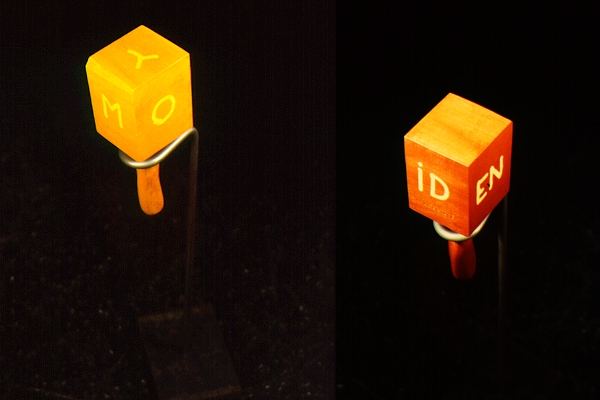
• Auction at Sculpture Space, Utica, NY 1993
L’installation comprends 11 maillets en bois teinté rouge ou jaune. Sur chaque maillet est gravé un mot idée: Temps, Space, Money, Loi, Duty, Riot, Assez, Rêve et Identité. Exploration de l’ambivalence et du contraste qui existe entre le concept de l’outil et le concept de l’arme, de la construction et la destruction.
Chaque maillet: 12 in h. X 5 in. w. X 5 in. d. tuge métallique: 30 in. h.
La boîte de Pandore (1991)
• Galerie d’art Louise et Reuben-Cohen de l’Université de Moncton, NB, 9 juillet – 31 août 2008
• A.K.A. Saskatoon, SK, June 7 – June 29 1991
• Galerie Sans Nom, Moncton, NB April 2 – April 23 1991
Created in January and February 1991 during a residency at Sculpture Space,Utica, NY, an internationally reknowned artist-in-residence program for sculptors.
The New Pandora’s box – an installation-projection about television.
I left Canada for England with a grant from the Canada Council – August 1, 1990 on the first leg of a world research trip. The idea was to revisit the myth of Pandora’s Box and to capture ‘evils of the world’ through video and sound recordings. The invasion of Kuwait by Iraq on August 2 forced me to change my itinerary and to reconsider the parameters of my research. During the 40 days of my travel, I saw a world glued to television sets, waiting for something to happen. Television as medium evolved to be both topic and base for my project.
The Installation was made of 5 elements, four buoys: rocking structures made of wood and the control cabinet: the disc. Each buoy was fitted with a slide projector and a cassette deck connected to the disc. Visitors could activate projections and soundtracks by opening the drawers of the cabinet.
The slides and the soundtracks were constructed with material garnered from television itself, photo stills and sound bites taken from talk shows and daytime TV.
The construction of The New Pandora’s Box took place at Sculpture Space from December 2, 1990 to January 30, 1991. Operation Desert Storm began with an aerial bombardment on 17 January.
Dimensions
4 pieces: 75 in h. X 24 in w. X 20 in d.
1 piece: 24 in dia. X 5 in h.
Soundtracks duration: 45 minutes
240 slides
Le poids de la beauté / The Weight of the Beauty (1990)
Work for 3 dead minks, one deer leg and 5 capitals
February 27 – March 1, 1990
Glyde Hall, The Banff Centre for the ArtsBanff, Alberta
Sur la route qui me ramène de Calgary
Au son de l’harmonica de Dylan
sur “What was it that you wanted”
Je croise un chien mort, so,
Je réalise que dans les Foothills,
on meurt aussi dans la Beauté
Cowboy Caruso (1990)
Saint Mary’s Unniversity Art Gallery Halifax, NS February 8 – March 11 1990
Cowboy-Caruso est une figure mythique qui veut le meilleur des deux mondes; la liberté et les grands espaces du cowboy et le raffinement du monde de l¹opéra. Basé sur l’histoire vraie de Ted Wilson ancien cowboy au Texas, travailleur dans les champs pétrolifères du Nord puis chanteur d¹opéra dans les rues de Calgary.
Deux structures reliées électriquement, l’une COWBOY, l’autre CARUSO engage via le spectateur un dialogue chaotique. Quatre tiroirs en forme de quart de lune peuvent être tirés hors de Cowboy. Chaque tiroir a une fonction spécifique: 1. déclenche le système sonore; le haut-parleur droit est installé dans Cowboy et le haut-parleur de gauche dans Caruso. 2. déclenche un baril tournant installé à l¹intérieur de Caruso. 3. déclenche un projecteur diapositives installé dans Cowboy. 4. déclenche un trophée tournant sur Cowboy. La structure Caruso est déposée sur une table de métal. Quatre chaises sont installées face à quatre ouvertures. Lorsque concordent les ouvertures dans le baril tournant avec les ouvertures sur la structure elle-même une scène mélancolique, éclairée avec des black light apparaît puis disparaît lentement. Il s¹agit d¹une forêt miniature faite de bois de chevreuils où pendent des médaillons photographiques. Sous la table sont éclairés avec des black light cinq fers à cheval fluorescents. La projection de diapositives vertes est constituée de gros plans de dessins de travaux quotidiens du cowboy. La bande sonore comprends des airs de l’ouest chantés par Ted Wilson. Le tout fut manipulé en studio.
Installation
2 pièces: 48 in. dia. X 12 in. h.
base de Cowboy: 48 in dia. X 48 in. h.
base de Caruso: 48 in. h. X 24 in. w. X 24 in. d.
Daniel H. Dugas
Archives
Blogroll
- A.I.R. Vallauris
- ACAD
- Adobe additional services
- Adobe Creative Cloud
- AIRIE
- Amaas
- Amazon Author Central
- ARTothèque
- Australian Poetry
- Basic Bruegel
- Bitly
- CCCA
- CDBaby
- Cycling 74
- Dissolution
- Éditions Prise de parole
- Emmedia
- eyelevelgallery
- FAVA
- Festival acadien de poésie
- Festival FRYE Festival
- FILE – Electronic Language International Festival
- Freeware list
- Fringe Online
- Galerie Sans Nom
- Gotta Minute Film Festival
- Instants Vidéo
- JUiCYHEADS
- Kindle Direct Publishing
- Klondike Institute of Art and Culture
- La Maison de la poésie de Montréal
- La Maison de la Poésie et de la Langue française Wallonie-Bruxelles
- Laboratorio Arte-Alameda
- Le Centre Jacques Cartier
- Liberated Words
- Maison Internationale de la Poésie – Arthur Haulot
- MediaPackBoard
- Miami Book Fair International
- Monoskop
- Mot Dit
- NSCAD University
- Paved Arts
- PoetryFilm
- Portail des auteurs du Nouveau-Brunswick
- RECF
- Revue Ancrages
- Salon du Livre du Grand Sudbury
- Sculpture Space
- Subtropics.org
- Sydney college for the arts
- The Centre for Contemporary Canadian Art
- The New Gallery
- Trevigliopoesia
- tumbler-documents
- V Tape
- Valerie LeBlanc
- VideoBardo
- Void Network-Κενο Δίκτυο
Categories
- #covidpoèmes
- Advertisement
- AIRIE
- Ancrages
- anthology
- Anthropocene
- Architecture
- Around Osprey
- art
- Article de presse
- arts visuels
- audio
- Australian Poetry
- Basic Bruegel Editions
- Book
- book fair
- Cafe Poet Program
- Ce qu'on emporte avec nous
- Citations gratuites
- Collaboration
- commentaire
- commentary
- Compte rendu
- conférence
- Conservation Foundation of the Gulf Coast
- COVID-19
- Critique littéraire
- culture
- Daniel Dugas
- Design
- Édition Michel-Henri
- Éditions Perce-Neige
- Éloizes
- Emmedia
- emoji etc | émoji etc
- Environnement
- essai
- essay
- Everglades
- Exhibition
- festival
- Festival acadien de poésie
- Festival Frye Festival
- FIPTR
- Flow: Big Waters
- Fundy
- Habitat
- installation
- Instants Vidéo
- interactivity
- journal
- JUiCYHEADS
- Kisii
- L'Esprit du temps
- laptop
- Leaving São Paulo
- lecture
- Livre
- logos
- Magazine
- Miami Book Fair
- Moncton 24
- novel
- OASIS
- oil spill
- perception
- performance
- Photo
- poésie
- Poetic Licence Week
- Poetry
- politics
- politique
- press
- Prise de parole
- Revue Ancrages
- salon du livre
- sculpture
- Sculpture Space
- sound
- Souvenirs
- Spirit of the Time
- Style & Artifacts
- Symposium d'art/nature
- talk
- television
- The New Gallery
- Uncategorized
- Valerie LeBlanc
- vidéo
- vidéopoésie
- Videopoetr/Vidéopoésie
- videopoetry
- visual arts
- What We Take With Us
- youth literature






